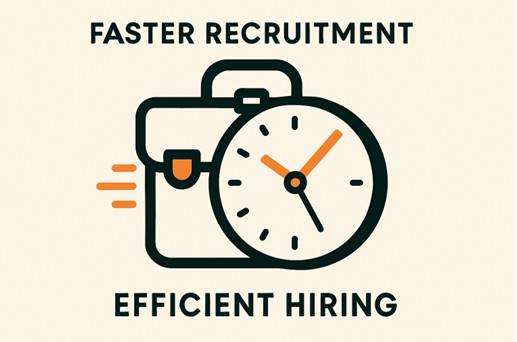In an era of fierce talent competition and roles remaining unfilled for longer, businesses are seeking every advantage to accelerate their recruitment cycles. The metric known as time to fill has become a pivotal benchmark for assessing recruitment efficiency and speed. A sluggish hiring process drives up operational costs and can also mean losing the best candidates to competitors who move faster.
Reducing time to fill is about more than just moving through steps quickly. Modern organizations are leveraging new strategies and technology to balance speed with quality, ensuring that business needs are met and that the right talent is hired. By adopting innovative solutions and optimizing workflows, companies transform their recruitment landscapes and stay competitive in a tight labor market.
Leveraging AI and Automation
Artificial Intelligence (AI) and automation are ushering in a new age for recruitment. Routine tasks that once slowed down hiring teams—such as sorting resumes and scheduling interviews—are now automated with AI-driven software. Intelligent resume screeners instantly surface top contenders, while automated scheduling tools eliminate back-and-forth emails, freeing up recruiters for higher-value activities.
Real-world results highlight this shift: giants like Unilever have compressed their hiring cycles from four months to four weeks, thanks to digital assessments and AI-powered ranking systems. By automating initial screenings and skill evaluations, companies enhance the speed and accuracy of their selections, enabling them to move from application to decision in record time.

Building a Proactive Talent Pipeline
Reactive hiring—waiting for a vacancy before sourcing candidates—often adds weeks to the recruitment process. In contrast, companies building a proactive talent pipeline constantly engage with potential future hires, creating relationships before roles open. This means nurturing communities, building employer brand recognition, and maintaining active networks of candidates with the experience and culture fit needed for future positions.
Leading organizations like Google have transformed their approach to hard-to-fill roles, especially in tech and engineering. By constantly connecting with candidates, engaging through events or talent communities, and maintaining up-to-date databases, they’ve slashed time-to-hire by as much as 40% for specialized positions. This pipeline-centric approach ensures critical roles are filled quickly and effectively, minimizing disruption to teams and operations.
Streamlining the Interview Process
The interview stage has traditionally been a significant bottleneck in hiring. Companies that overhaul their interview practices often see immediate reductions in time-to-fill. Standardized, structured interviews bring consistency and transparency, enabling faster feedback and fairer outcomes.
For example, Netflix recently trimmed its hiring timeline from six weeks to just two. The company achieved this by paring down unnecessary interview rounds, giving hiring managers more power for faster decision-making, and ensuring each interview stage was purposeful and efficient. By focusing only on the most relevant interview steps, businesses expedite the selection process without sacrificing thoroughness or quality.
Enhancing Candidate Experience
Fast, efficient hiring isn’t just about internal improvements—it’s also about attracting engaged and motivated candidates. Companies that provide a positive, seamless experience throughout the hiring journey are in a much stronger position to move quickly. This includes simple application forms, prompt feedback, and clear communication at every stage.
Southwest Airlines offers a prime example: their application process can often be completed in minutes, eliminating barriers that could deter qualified applicants. The focus on ease and transparency encourages top talent to swiftly engage and move through the pipeline. Research from Harvard Business Review further confirms that candidate-centric practices speed up hiring and improve offer-acceptance rates and employer reputation.
Utilizing Data Analytics
Data analytics play a vital role in modern hiring strategies. By examining recruitment funnel metrics—such as candidate drop-off rates, source effectiveness, and specific bottlenecks—organizations can more precisely uncover inefficiencies and target improvement areas. For instance, Uber’s recruitment team harnessed analytics to discover where candidates were exiting their process and adjusted their workflow, reducing their average time-to-hire by 35%.
Access to real-time dashboards and analytics platforms enables recruiters to monitor performance continuously and make data-driven decisions. Metrics-driven hiring supports ongoing optimization efforts, ensuring recruitment stays aligned with organizational goals and candidate expectations.
Implementing Flexible Workforce Strategies
Modern companies also embrace flexible staffing models to address immediate talent needs while maintaining long-term agility. Organizations can rapidly deploy skilled professionals for temporary or project-based assignments through partnerships with staffing agencies and robust contingent worker programs, bridging talent gaps during peak periods or leaving roles open for permanent scouting.
This approach controls time-to-fill and enables smoother transitions and business continuity, ensuring that productivity doesn’t suffer while longer-term hiring decisions are made. Fortune 500 companies, in particular, cite increased responsiveness and reduced operational risks as crucial benefits of these flexible workforce strategies.
Conclusion
Reducing time-to-fill requires an ongoing commitment to innovation, strategy, and data-driven refinement. By embracing AI and automation, maintaining a proactive talent pipeline, streamlining interviews, prioritizing candidate experience, and leveraging analytics, companies position themselves for agility and lasting success. In today’s fast-moving market, these techniques are not only about operational speed—they’re about securing the best talent and gaining a decisive competitive edge.
